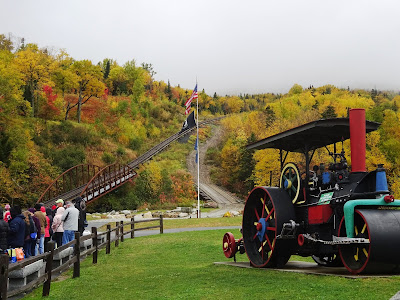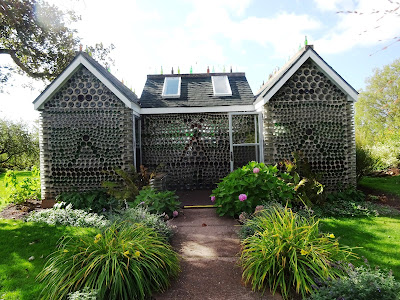Saturday, Sept. 28--Our first stop this morning was at a potato farm. Alvin Keenan's Irish ancestor came to Prince Edward Island in the late 1800s. Alvin has 1000 acres where he grows mostly Russet potatoes which mainly become french fries. He rotates the crop with grains and only plants potatoes in a field every three years. But with 1000 acres, he harvests lots of potatoes every year. They were ready to begin harvesting on Monday so we were a tad too early to see them digging. He showed us his equipment and explained how it works.
A six-row picker costs $500,000.
Next he took us through the packing house and showed us how the potatoes are prepared for shipping. They can process about one acre per hour. A full harvest crew is fifty people, ten in the packing house and the rest in harvest and delivery.
These plastic bags are filled with baking potatoes.
As we went on our way we saw another farm where they were digging potatoes, so we got to see some of the action there.
We stopped next at the Souris Lighthouse and went up in it. Below is the view from both sides.
A young Amish family moved in from Ontario and operates a little country store called Seven Mile Road Gift Shop. One of the ladies on the bus thought it was a huge store if it's seven miles long. Not so. They had craft items, quilts, housewares, toys, and other things usually found in a country store. We bought very little besides food on this trip but at this store I did break down and buy a small lighthouse to put in my lighthouse bathroom.
We needed to be at the ferry boat dock by 3:30 to cross from PEI to Nova Scotia. We didn't want to miss the boat and made sure we were there on time. It was a 14-mile, 70-minute crossing. There was plenty of room for a big bus. We were free to walk around on deck during the crossing. It was going toward evening and rather cool on top.
This is a fisherman's wharf next to the ferry dock.
The sun was going down but this was the best picture I could get of the sunset.
We slept in Glasgow, Nova Scotia, Saturday night and got to sleep in a bit Sunday morning as church did not start until 10 a.m. (We were usually on the road by 7 or 7:30 a.m.)
Sunday, Sept. 29--We attended services at the Lighthouse Mennonite Church which is affiliated with the Nationwide Fellowship group. They are in the process of adding a school to the church building. The current school is on the right end of the church and the new one will be on the left.
They had a fellowship meal after church and fed all of us a good lunch. We visited until 3 p.m. and then went on our way to our motel near Baddeck.
Monday, Sept. 30--It rained overnight and was in the 40s in the morning. It was time to dig out our heavy jackets! We spent most of the day driving through the long winding Cabot's Trail road on Cape Brenton Island which is the north finger of Nova Scotia. The main thing to see there are rocks, water, and trees, or trees, rocks, and water. There is a lot of calendar-picture scenery and I wound up with lots of rocky shore pictures.
At one place there was a pebbly beach where a few brave souls took off their shoes and waded in. I passed and just took pictures. I loved to watch the surf but from a distance.
Meanwhile, Leroy walked back a ways to see a waterfall. He was the only person to go there. Someone said, "There goes that old guy that thinks he's young." But he was rewarded by getting pictures no one else had. Well worth the hike!
Another interesting place we stopped to see was the Aspy Fault. One slope of the mountain has hard rock and the opposite slope is soft rock. The Aspy River runs through the bottom of the canyon. The sign said it was formed over millions of years but I have a more simple and sensible explanation that happened only a couple thousand years ago.
Tuesday, Oct. 1--We went to the famous Peggy's Cove on Tuesday morning. It's a little fishing village with a lighthouse on a rocky point.
The place was crawling with tourists. There were eleven buses there plus a lot of people who drove there in their cars. It was impossible to get a good picture of the lighthouse without people on it. But I can't complain because I was probably spoiling someone else's picture with my presence. I didn't go up in this one because it was too full of people. I was pleased to be able to walk around on those rocks. I couldn't have done it a week earlier. I finally got a picture of a wave splashing against the rocks. It's hard to catch it at the exact right moment.
A bagpiper was playing there as well as several other places. Nova Scotia is Latin for New Scotland. They seem proud of their heritage and are making an effort to keep it alive.
We had lunch at Peggy's Cove and then went to the Maritime Museum in Halifax. This buoy sat outside the museum. I didn't know they are this big; they look a lot smaller bobbing around in the ocean.
To me, the most interesting part of the museum was the artifacts from the Titanic. Three ships sailed out of Halifax to recover bodies after the Titanic sank. Some pieces eventually drifted ashore.
A piece of the Grand Staircase.
The undertaker who prepared the bodies for burial kept the shoes of a 19-month-old boy who died. After the undertaker died, his family found the shoes and donated them to the museum. The boy was the youngest of a Goodwin family of eight from Wiltshire, England. They all died but the boy's body was the only one recovered.
Another piece that got my attention was this boat on wheels. Why would anyone want wheels on their boat? It turned out to be a lifeboat. It was kept this way so it could quickly be hauled to wherever it was needed to go out on a rescue.
Wednesday, Oct. 2--We drove four hours Wednesday morning to the Bay of Fundy in New Brunswick. There was light intermittent drizzle but it didn't stop us. The tide was out so we went down 99 steps and walked around on the ocean floor. Huge rock formations were fully exposed with only seaweed clinging to their feet.
Here I am standing under those two huge "kissing" rocks. (center, facing camera)
Below are a couple free-standing rocks they call flower pots.


The Bay of Fundy has the highest tides in the world. The average tide is three feet but here it is 32 to 46 feet. The high tide is the result of the length and funnel shape of the bay and the volume of the water. It takes six hours for the tide to come in and six hours to go out, so the water is constantly sloshing in and out. There are two high and two low tides each day.
We ate lunch and then went back to see how high the water was. This is how it looked two and a half hours after we walked on the ocean floor. The guide said it would rise at least another seven feet, nearly to the top of the arch I stood under before lunch.
Before going to our motel at St. John, New Brunswick, we checked out a river that is called the Reversing Falls because it flows both ways subject to the tide. The water was slowly flowing in and there was no resemblance to a falls.
Thursday, Oct. 3--Before leaving town in the morning we went back and the water was rushing out, going the opposite direction. I was glad we saw it going both ways.
We crossed the border at St. Stephens and were back in the U. S. where they have greenbacks instead of funny colored "Monopoly" money. This day was all driving to our motel at North Conway, New Hampshire.
Friday, Oct. 4--We left our motel at 7 a.m. and drove about 40 minutes to Mt. Washington where we took the cog railway to the top. The foliage here was the most colorful we had seen anywhere.
The trees became smaller and smaller as we rode up the 6,288 ft. mountain and then disappeared altogether at the top. It was 26 degrees and foggy at the top with a 40 mph wind. We couldn't see a thing and it was
cold.
I hurried to the building and stayed there while Leroy went up on the icy observation deck. He didn't stay there long. After about an hour we got on the train again and rode back down. The only thing that grew at the top was some grass that was covered with icy frost, which the brakeman said was actually frozen clouds.
So much for an expensive ride to the top of a mountain to see fog. The gold was at the bottom of the mountain!
We got lunch at Mt. Washington before starting on the last leg of the journey toward home. We stopped once in Vermont to see the Quechee Gorge. There was a walkway on both sides of the bridge on this busy road where we could cross safely to see the gorge. This is the view of the gorge from both sides of the bridge.
New Hampshire and Vermont were two states I had never been in but now I had my feet on the ground of both of them. After this, we settled down in the bus and set our sights on home. We slept in Queensbury, NY that night.
Saturday, Oct. 5--We left our motel at 8 a.m. and headed straight home. We stopped at a Cracker Barrel in NJ for lunch. Things were looking more and more familiar as we got closer to Ephrata. After traveling 3,211 miles, we were back where we started. Our car had been parked there and some still unknown person had been there ahead of us to welcome us back.
Thank you! We did. That's one more thing crossed off our bucket list.









































































